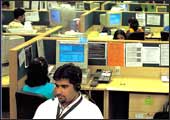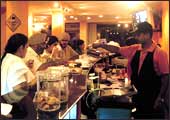 |
|
EARN
|
 |
|
SPEND...
|
 |
|
SPEND...
|
 |
|
SPEND!
|
Here are five, no
make that six, in a Qualis trying to set a new land-speed record for
the distance between Delhi and Gurgaon, India's official call centre
capital.
Here are a handful at the Barista outlet off
Bangalore's mg Road.
Here are several score at Chennai's Shoppers'
Stop.
But 33 million?
Actually, that's a conservative estimate.
Retail specialist KSA-Technopak claims retail
chains, fast food outlets, travel and hospitality businesses, and
banks, insurance firms and telecom companies employ around 43.5
million people, mostly in frontline sales functions, and largely
(between 80 and 85 per cent), young people-in the 20-30 age group,
and more 20-plus than 30-minus. India's association of software
services companies estimates that the it-enabled services and BPO
space employs around 1.60 lakh people. An unadventurous 75 per cent
of 43.5 million, plus the Nasscom estimate gives us a grand total
of 32.76 million.
The Rs 1,00,000-crore calculation is straightforward:
the average yearly salary of frontline sales pros-let's call them
customer jockeys-is around Rs 1,00,000. Assuming that 30 per cent
of this is disposable or discretionary income, India's 33 million
customers spend close to Rs 1,00,000 crore, money that goes in clothes,
eating out and entertainment, electronics goods such as televisions
and CD players, even motorcycles, cars, and in the rare case, houses.
If the Indian economy hasn't gone under in these troubled times,
surely, these 33 million have had a part to play in it?
-Moinak Mitra
THE
COMPARISON
Just how well paid are India's customer jockeys?
 Temps
dominate the services sector in the US, filling in second jobs,
even third ones for a few hours a day for that little extra. "Unemployment
rates in India are so high that we don't need to do this,"
says Ravi Deol, the CEO of coffee chain Barista. Still, salaries
in India are a fraction that in the US. KSA-Technopark estimates
that a shop-floor assistant in India could earn between Rs 4,000-6,000
a month, much lower than the $1,500-2,000 (Rs 72,000-96,000) a similar
position in the US would fetch. And Nasscom estimates that an entry-level
call centre agent in the US earns about three times what an employee
at a similar level in India would (around Rs 12,000 in India and
Rs 36,000 in the US). The call centre and Business Process Outsourcing
types, then, are better off than their American counterparts if
purchasing power parity is taken into consideration (a rough and
ready comparison can be effected by multiplying the Indian salary
by 5). Organised retail is a different story altogether-even after
factoring in purchasing power, Indians employed in the sector earn
between a fourth and fifth what their counterparts in the US do. Temps
dominate the services sector in the US, filling in second jobs,
even third ones for a few hours a day for that little extra. "Unemployment
rates in India are so high that we don't need to do this,"
says Ravi Deol, the CEO of coffee chain Barista. Still, salaries
in India are a fraction that in the US. KSA-Technopark estimates
that a shop-floor assistant in India could earn between Rs 4,000-6,000
a month, much lower than the $1,500-2,000 (Rs 72,000-96,000) a similar
position in the US would fetch. And Nasscom estimates that an entry-level
call centre agent in the US earns about three times what an employee
at a similar level in India would (around Rs 12,000 in India and
Rs 36,000 in the US). The call centre and Business Process Outsourcing
types, then, are better off than their American counterparts if
purchasing power parity is taken into consideration (a rough and
ready comparison can be effected by multiplying the Indian salary
by 5). Organised retail is a different story altogether-even after
factoring in purchasing power, Indians employed in the sector earn
between a fourth and fifth what their counterparts in the US do.
-Priya Srinivasan and Moinak Mitra
THE
SOCIAL COST
India, detractors say, is encouraging the creation
of a race of under-achievers.
 Meet
Samir Desai, a 22-year old who signed on at a multiplex last year.
He was to function as its cashier, would earn Rs 10,000 a month,
and the hours were good. He maintains that he "basically wanted
a job that would pay well, have fixed hours and that wouldn't require
too much brainwork." Nothing wrong with that. Only, as Subramonia
Sharma, the director of entrepreneurship development at Hyderabad's
Indian School of Business, puts it, "Once into these jobs,
the achievement goal undergoes a change; the kids stop aiming for
specific career goals and get caught up with the lifestyle trappings
this money can bring-beer, bikes, and whatever else is in vogue
with the peer group." In most jobs of this nature that have
been created, says Purva Misra, a senior consultant at hr consulting
firm Hewitt Associates, "there is no growth beyond three levels."
The presence of MBAs from second-tier B-schools, chartered accountants,
engineers, even doctors in call centres, frontline sales, and customer-interface
positions proves that Sharma isn't far off the mark in his assessment.
Still, what's the option? Meet
Samir Desai, a 22-year old who signed on at a multiplex last year.
He was to function as its cashier, would earn Rs 10,000 a month,
and the hours were good. He maintains that he "basically wanted
a job that would pay well, have fixed hours and that wouldn't require
too much brainwork." Nothing wrong with that. Only, as Subramonia
Sharma, the director of entrepreneurship development at Hyderabad's
Indian School of Business, puts it, "Once into these jobs,
the achievement goal undergoes a change; the kids stop aiming for
specific career goals and get caught up with the lifestyle trappings
this money can bring-beer, bikes, and whatever else is in vogue
with the peer group." In most jobs of this nature that have
been created, says Purva Misra, a senior consultant at hr consulting
firm Hewitt Associates, "there is no growth beyond three levels."
The presence of MBAs from second-tier B-schools, chartered accountants,
engineers, even doctors in call centres, frontline sales, and customer-interface
positions proves that Sharma isn't far off the mark in his assessment.
Still, what's the option?
-Priya Srinivasan and Moinak Mitra
THE
BOOM THAT WILL BE
India's services boom and the resultant explosion
in employment-opps are here to stay.
 The
past two years haven't exactly been great ones for the Indian
economy but you'd never know that if you looked at the services
sector-it grew by 6.8 per cent in 2001-02 and by 7.1 per cent
in 2002-03, as compared to the overall economic growth rate of
5.6 per cent and 4.4 per cent. That has meant jobs-manning counters
at multiplexes or the aisles in supermarkets, serving customers
at restaurants, fast food outlets, pubs, and coffee bars, interacting
with customers, both local and international, over the phone,
and selling a range of services from cellular connections to auto
loans to mortgages. With the services sector estimated to grow
at 7 per cent in 2003-04 and 7.2 per cent in 2004-05, this trend
is likely to continue. Don't write this boom off yet. The
past two years haven't exactly been great ones for the Indian
economy but you'd never know that if you looked at the services
sector-it grew by 6.8 per cent in 2001-02 and by 7.1 per cent
in 2002-03, as compared to the overall economic growth rate of
5.6 per cent and 4.4 per cent. That has meant jobs-manning counters
at multiplexes or the aisles in supermarkets, serving customers
at restaurants, fast food outlets, pubs, and coffee bars, interacting
with customers, both local and international, over the phone,
and selling a range of services from cellular connections to auto
loans to mortgages. With the services sector estimated to grow
at 7 per cent in 2003-04 and 7.2 per cent in 2004-05, this trend
is likely to continue. Don't write this boom off yet.
-Ashish Gupta
1
2
|

